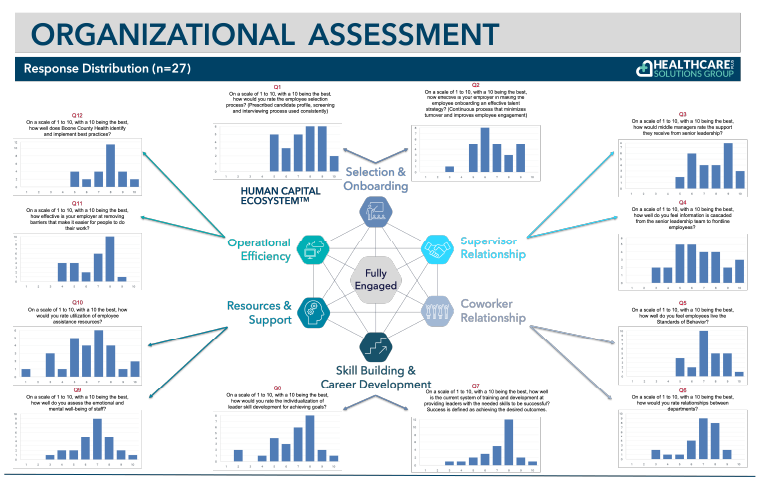As you read in “Rewiring Excellence: Hardwired to Rewired”, The Human Capital Ecosystem™ Assessment is a leader-friendly version of holding up the mirror to look at how we’ve done things in the past and how we might re-imagine things going forward. What’s in? What’s out? This process gives the organization the opportunity to ask for and listen to the voice of the entire leadership team and more. As you’ll see referenced later in the explanation of each of the ecosystem elements, engaging the all-important middle leader group is key to building (or in some cases re-building) trust. If senior teams do a good job of saying “we want your input” and then acting upon the results, middle leaders will quickly align and carry important messages across their departments.
We’ve completed these assessments with organizations of just about every size, shape, and function within healthcare. Each time we’ve completed one, leadership teams tell us that it helps make priorities even clearer, in terms of where they should focus immediately vs. trying to take on all things related to their retention and engagement efforts.
Here’s how the assessment process works:
- We meet with the senior team so they can first see and become familiar with the ecosystem: its components and its ultimate goal of driving engagement and sense of belonging.
- We then send the survey to the group of leaders the team identifies (we suggest a larger group vs a smaller one). We find each organization easily identifies the group. Often it is those who attend leadership sessions.
- Once assessments are complete, we begin to assemble the feedback in two ways:
- A placemat, or large format visual that it easy to read and translate regarding the responses and what they indicate.

- A placemat, or large format visual that it easy to read and translate regarding the responses and what they indicate.
- A presentation designed to create active conversation among the entire leadership team.
- As we discuss the results for each set of questions, our guidance is for the leaders to avoid the temptation to focus first on the lower scores and/or outliers. The key element of the visual is the distribution curve…Does it lean left? Does it lean right? Is it closer to a perfect bell curve and where does the peak of the distribution fall? These answers begin to give a senior team and their middle leaders a sense of where the variance lies within their organization. It also begins to give them a sense of prioritization.
In cases where leader’s responses tend to cluster to the right (higher scores/higher current performance), that element is less likely an immediate priority. For those responses that either show a wide spread of answers or cluster to the left (lower scores, poorer current performance) that element is more likely to emerge as a priority. In the almost every case where the assessment has been taken, 2-3 of the elements of the ecosystem emerge as priories for focus.
No two organizations are exactly the same. These “rewired assessments” become very healthy conversations. Sometimes there are surprising results. Often, results will serve as validation for senior teams’ perspectives of the organization. Without fail, someone from the ranks of the middle leaders will say something like “It was good to be asked” or “It was nice to have our input valued.”






